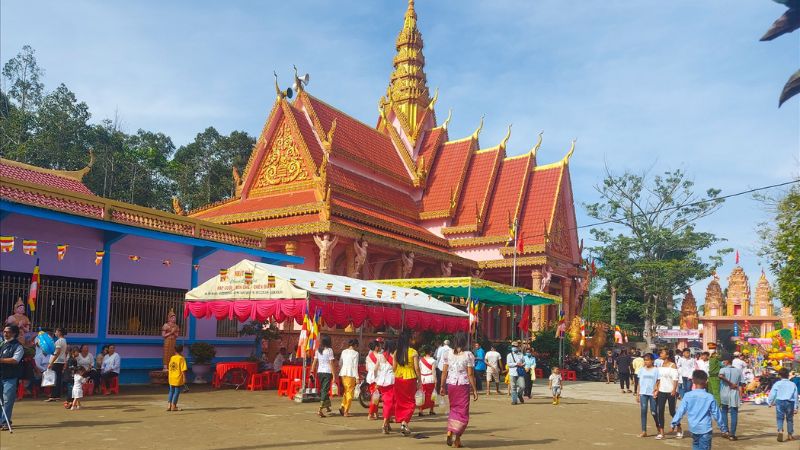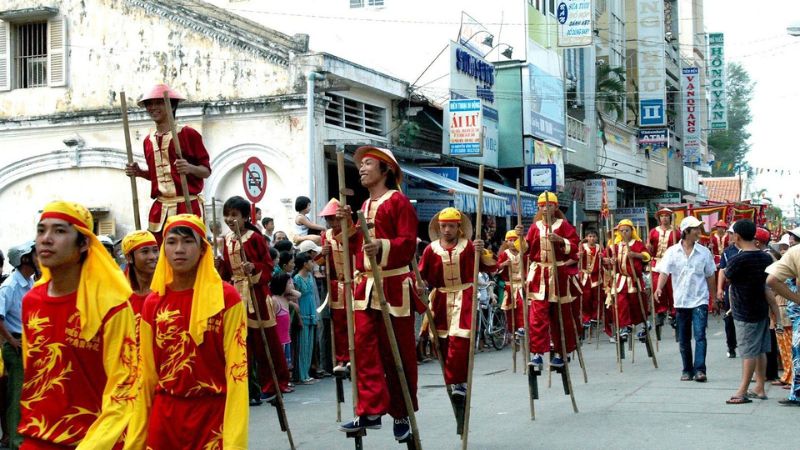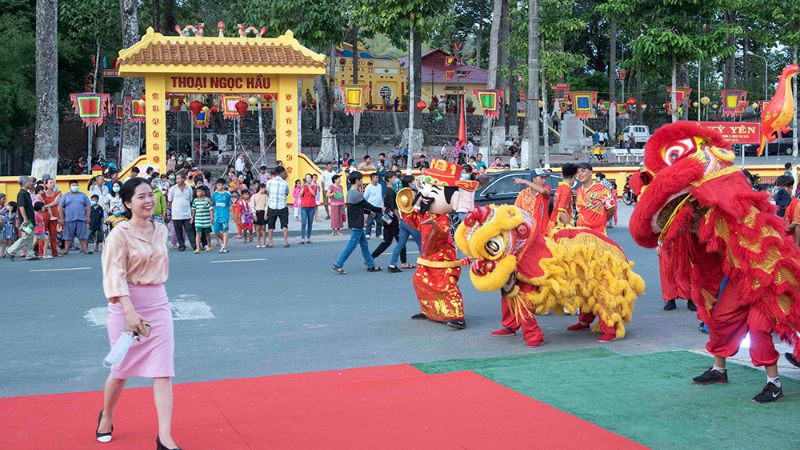The traditional festivals of An Giang province have many unique customs and activities that attract a large number of tourists every year. Let’s explore the following 7 traditional festivals of An Giang to see what makes them special!
1 The Khmer Ethnic Festival in An Giang
The Dolta Festival and Seven Mountains Buffalo Racing Festival
The Dolta Festival of the Khmer ethnic people is one of the important festivals, taking place from August 29th to September 1st. The Dolta Festival is similar to the Vu Lan Festival of the Kinh people, it is an occasion for people to remember and pray for their ancestors.
The Khmer people will go to the temple to worship the monks, make offerings, and pray for good luck for their families. This festival is also associated with the unique Seven Mountains Buffalo Racing Festival, which attracts the attention of locals and tourists.
 Dolta Festival
Dolta Festival
Chol Chnam Thmay – The Traditional Festival of An Giang
Chol Chnam Thmay Festival is considered as the New Year’s Day of the Khmer people. The festival takes place according to the Khmer calendar, usually around April 14th to April 16th in the Gregorian calendar.
On the first days of the Khmer New Year, they will wear traditional colorful costumes, bathe in fragrant water, clean their houses, and go shopping to prepare for the festival. Besides, the Khmer people also go to the temple to pray, play traditional games such as drum dancing, kite flying, candle dancing, firecrackers, and spinning tops.
 Chol Chnam Thmay – The Traditional Festival of An Giang
Chol Chnam Thmay – The Traditional Festival of An Giang
2 The Traditional Festivals of An Giang for the Kinh People
The Chau Phu Shrine Festival
The Chau Phu Shrine Festival is held from May 9th to May 11th of the lunar calendar every year. The festival takes place at the Chau Phu shrine, which is dedicated to Thanh Hoang Nguyen Huu Canh, a person who opened up the Southern land.
The Chau Phu Shrine Festival is held to commemorate the contributions of those who opened up the land and to pray for peace, prosperity, and happiness.
 The Chau Phu Shrine Festival
The Chau Phu Shrine Festival
The Bang Lang Shrine Festival
Every year, the Bang Lang Shrine Festival is held from the 15th to the 16th of March of the lunar calendar at the Bang Lang Shrine. The festival has a small scale but is a unique cultural feature of the Chau Doc region, An Giang.
 The Bang Lang Shrine Festival
The Bang Lang Shrine Festival
The Bao Sanh Shrine Festival
The Bao Sanh Shrine Festival is a festival of Long Son commune, Tan Phu district, An Giang. The festival is held on the 15th of January of the lunar calendar. The local people worship Ong Lao Ya (or Lao Gia) and believe that he is a deity who helps people.
 The Bao Sanh Shrine Festival
The Bao Sanh Shrine Festival
The Ky Yen Festival at the Thoai Ngoc Hau Temple
The Ky Yen Festival takes place at the Thoai Ngoc Hau Temple in Thoai Son for 3 days from April 9th to April 11th of the lunar calendar each year. The festival is a way for the people of An Giang to express their gratitude and respect to Thoai Ngoc Hau and the deities who contributed to the construction of the Vinh Te Canal, which provided water for the fields.
The traditional festival at the Thoai Ngoc Hau Temple starts with the procession to commemorate the deities around the temple. After that, the representative performs rituals such as reading the requests to the deities, offering incense, and performing worship. After the traditional ceremony, there will be a festival with unique artistic performances such as lion and dragon dancing, traditional singing, creating a lively and vibrant atmosphere.
 The Ky Yen Festival at the Thoai Ngoc Hau Temple
The Ky Yen Festival at the Thoai Ngoc Hau Temple
The Miếu Bà Chúa Xứ Festival at Sam Mountain
The Via Ba Chua Xu Nui Sam Festival is one of the important festivals in the Seven Mountains region, attracting a large number of visitors from all over to participate in the offering and worship. The festival lasts from April 22nd to April 27th according to the lunar calendar.
During the festival, visitors will experience traditional rituals such as the procession of the statue of Ba Chua Xu from Sam Mountain to the temple, the bathing of Ba Chua Xu’s statue, the worship of the male deity, the Tuc Yet ceremony, the Chanh Te ceremony, and the Hoi Sac ceremony, which are organized solemnly. The first two days of the festival focus on rituals, while the following two days bring folk entertainment activities, giving people the opportunity to experience the festive atmosphere.
 The Miếu Bà Chúa Xứ Festival at Sam Mountain
The Miếu Bà Chúa Xứ Festival at Sam Mountain
Above are 7 unique traditional festivals of An Giang that we want to introduce to you. We hope the article has provided you with useful information.

































